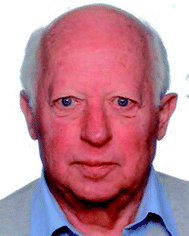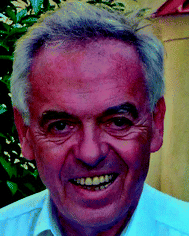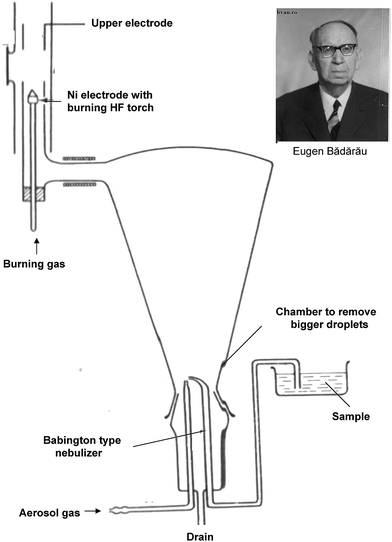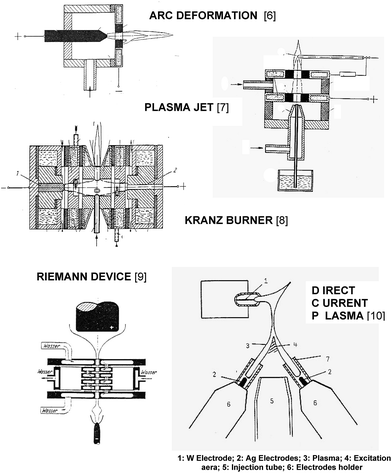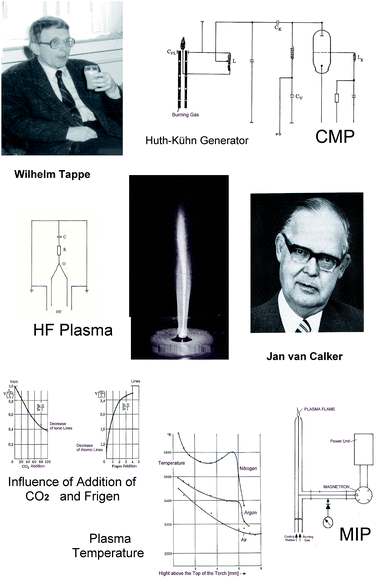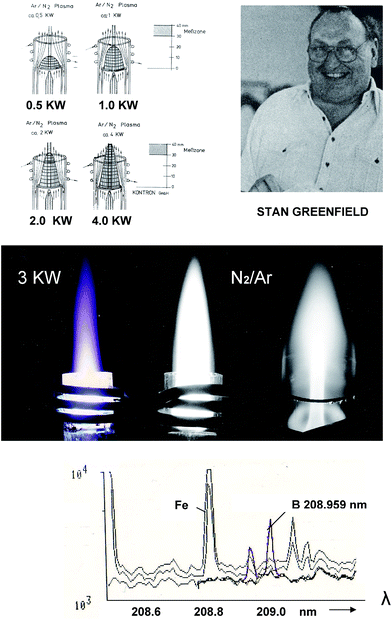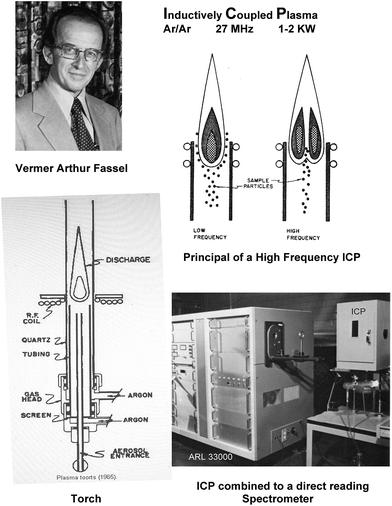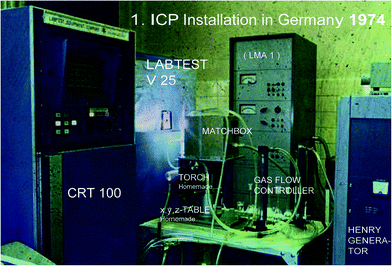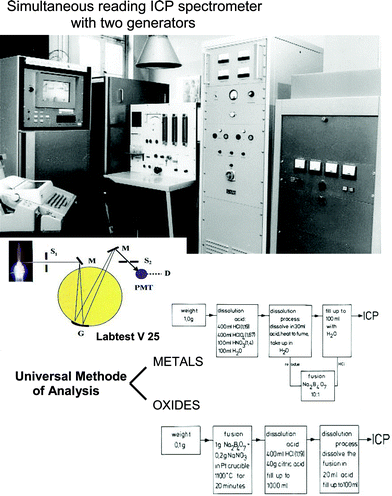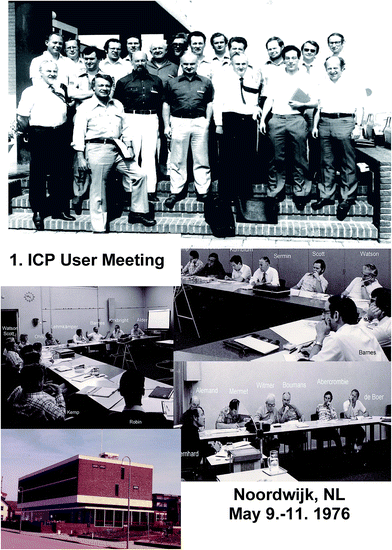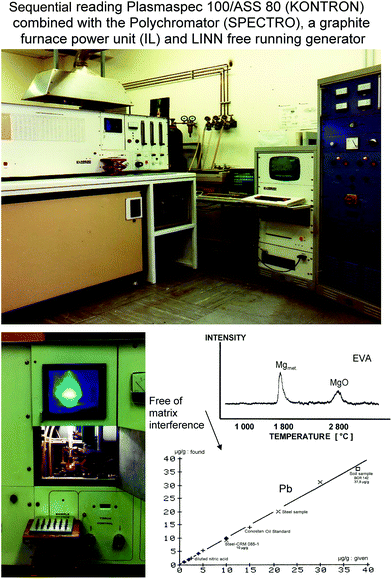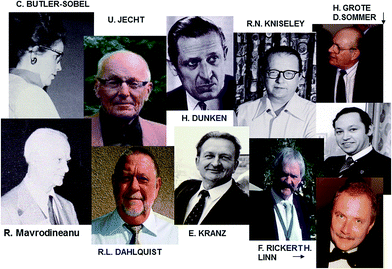History of inductively coupled plasma atomic emission spectral analysis: from the beginning up to its coupling with mass spectrometry
Knut
Ohls
*a and
Bernhard
Bogdain
b
aBüngerstraße 7, D-44267, Dortmund, Germany. E-mail: prof@knutohls.de
bIm Jägerviertel 19, D-85764, Oberschleißheim, Munich, Germany
An ionised and luminous gas is called a physical plasma. It contains free electrons and ions interacting with electric and magnetic fields. In the field of plasma physics this has been known for more than 150 years. Sometimes the physical plasma is called the fourth state of aggregation, because by supplying energy to the solid state, or aggregation, it normally passes at first into the liquid and thereafter into the gaseous state of aggregation. A further supply of energy will then lead to the physical plasma. Knowledge about physical plasma began with studies of gas discharge tubes by Julius Plücker (1801–1868) in Heidelberg and Bonn, and by his student Johann Wilhelm Hittorf (1824–1914), who later on examined electrodeless ring discharges in Münster (Germany). The two of them published an article in 1865 called, “On the spectra of ignited gases and vapours with regard to the same elementary gaseous substance”.1 Sir Joseph John Thomson (1856–1940) explained the processes in plasmas2 and discovered the electron. In 1928 the term “plasma” (from the Greek: πλάσμα = formation, structure) was introduced3 by Irving Langmuir (1881–1951). Early efforts to maintain an induction plasma on a stream of gas could be attributed to G. I. Babat.4 The 1960s were the initial period of thermal plasma technology. Thereafter, it was only a matter of time before analytical spectroscopists discovered induction plasma as a spectral excitation source.
The first application of such an induction plasma to the best of our knowledge was described by Eugen Bădărău (1887–1975) and co-workers, Bucharest (RO) about 60 years ago.5
At the VI Colloquium Spectroscopicum Internationale held in Amsterdam in 1956 Bădărău’s team reported their studies about a high frequency torch discharge as a spectral source (Fig. 1). It looks like a single electrode induction plasma (later known as CMP). The nebulizer seems to have been the Babington type which was used later on for example as a Giess-McKinnen-Kaiser nebulizer. Unfortunately this publication was largely ignored, possibly because it was written in German. In the 1950s spectral analysis of solid conductive materials was already applied successfully for routine applications. Then the search started to analyse solutions in the same way. Further development took place in several directions. One of them (Fig. 2) was the deformation of the electric arc to a flame.6 This approach resulted in the Plasma Jet7 and ultimately in the burner of Erich Kranz (*1927). For the first time, the solution to be analysed was not in contact with the electrodes.8
Finally this research resulted in the DCP (Direct Current Plasma) approach.
1961–1965 was a period of great importance for the development of plasma excitation sources. It started in two separate paths which can be referred to as the English and the German-USA path.
The first approach led via G. I. Babat and T. B. Reed to Stanley Greenfield.4 Reed used a high power induction torch source in 1961 to grow refractory crystals.11 He was the first who protected the torch wall by a stream of argon.
The second approach was not as clearly structured, because several scientists initially investigated plasmas with different generators (direct, capacitive or inductively coupled). This took place almost simultaneously, resulting in the work of Velmer A. Fassel.
However, all of it actually began in Münster (Germany) where Jan van Calker (1918–1981) experimented with r.f. generators. Together with W. Tappe (*1934) he observed high current sparks and tested their use as a source within his thesis.12 He also compared microwave induced plasma with capacitive coupled microwave plasma and inductively coupled plasma excitation.13,14 He tested the appropriate generators, searched for the best usable frequency, and applied different burning gases (argon, nitrogen and air). Spectra were recorded and detection limits were obtained spectrographically by using photographic plates (in μg ml−1 level).
In the same year (1963) also U. Jecht and W. Kessler from Munich studied various plasma sources (MIP) for analytical application.15
In Japan, M. Yamamoto and S. Murayama described the electrode erosion in a radio-frequency torch discharge,16 possibly to use the metal vapour for coating procedures.
In 1964 Tappe visited the USA and reported his results (Fig. 3).
In the meantime; R. Mavrodineanu and R. C. Hughes had examined all possible plasma sources including a low power one at 30 MHz and the MIP at 2.4 GHz.17 One year later C. D. West and D. N. Hume had built their spectrometer, which used plasma excitation mainly in the MIP mode.18
At the same time H. Dunken, G. Pforr and W. Mikkeleit were operating an ultrasonic nebulizer to insert analyte solutions into a plasma excitation source19 in Jena (Germany).
By 1964 the first route of development was successfully completed.
S. Greenfield was the first to apply an inductively coupled plasma source generated by a high power generator for analytical purposes at the company Albright & Wilson in the UK.20 Greenfield examined different possibilities in his laboratory; inserting the analytical solutions by means of the injection technique in small volumes. Hence, his ICP was called the Greenfield plasma which meant high power of more than 3 kW with nitrogen as a cooling gas and argon as plasma gas (Fig. 4). He once said: “You can put anything you want into the plasma, it still works”. In any case there was also enough time for tuning and the practical application of his ICP would be the only example for more than 10 years.
It is typical that developments in industry take a long time before they are accepted by research laboratories, universities or manufacturers.
One exception in this respect was V. A. Fassel (1919–1998), the former director of the Ames Laboratory at Iowa State University and the US Atomic Commission, later called Energy and Mineral Resources Research Institute. After W. H. Tappe visited Fassels laboratory the developmental process started to move quickly. Thus, in 1965 appeared the first publication on the use of plasma spectral excitation by R. H. Wendt and Fassel21 which was quickly followed by others23,27,31 for instance by Greenfield and co-workers20,22,40,42 in the following years. The ICP described by Fassel and co-workers was of low power (about 1–2 kW) using argon as a cooling gas as well as plasma gas, and it was called the Fassel plasma.
In the second half of the sixties research increasingly dealt with the principles of ultrasonic nebulization,24 and general applications of ICP. This work was also performed and reported by state institutions in London25 and Rome.26 The beginning of ICP research in France was started by J. Robin and J. Michel Mermet using ultrasonic nebulization in Lyon,28 where J. van Calker gave his lecture at the VI C.S.I. in 1961. M. Margoshes also started the evaluation of ICP29 and the Fassel team could already determine elements at the nanogram per millilitre level.31 In addition to the theoretical studies of L. de Galan, R. Smith and J. D. Wine-fordner30 or R. C. Miller and R. J. Ayen,34 one should also remember the early studies by the group of I. Kleinmann32,38 in Prague (CZ) and the private investigations of E. Kranz33 in Ilmenau (East-Germany). Following the reform of universities in 1968 all research on plasma spectroscopy was cancelled in East-Germany. At that time no purchasable spectrometer working with ICP excitation was available world-wide.
By the early seventies the long awaited first ICP instruments were supplied. Comparison with MIP excitation was important to realize the benefits of ICP,35 which was also mentioned in a handbook.36 Primarily due to the work of Greenfield and co-workers,39,40,42 new work was published including the first publication in Japan,37 G. F. Kirkbright in London41 and J. Robin in Lyon.43 They were studying optimized conditions for the ICP38 and methods for the determination of elements in different sample materials. For the first time, a publication by P. Boumans and a co-worker from Eindhoven appeared.44 Both were working for the Philips company which was a potential manufacturer of optical emission spectrometer devices at the time.
1973 and 1974 became very important for the further development of ICP excitation, instrumentation and analytical methods. Both authors of this Editorial met R. M. Barnes and V. A. Fassel at the XVII C.S.I. 1973 in Florence after Barnes’ lecture. Our meeting with the two scientists from the USA was of an unusual mixture because we were from a commercial laboratory (HOESCH Steel Company) and an analytical instrument sales engineering company (KONTRON), and to say the least, we were inspired by their work.
To further explain, KONTRON had entered the atomic emission spectroscopy business in Europe with a USA manufactured model LABTEST V 25 in early 1973. Therefore, the 1973 Colloquium Spectroscopicum Internationale held in Florence (Italy) for KONTRON was an ideal forum to meet many leading analytical chemists and spectroscopy users in one location. An invitation dinner in the hotel Villa Medici had been organized by KONTRON to bring the attendees together (110 by number) in a casual atmosphere.
From this conference and dinner party a group of laboratory leaders, primarily from the German steel companies, evolved taking a closer interest in the LABTEST technology. This in turn led to a product conference in Munich, the home of KONTRON, in February 1974.
In the course of conversation on the subject of “ICP”, the work of Fassel and Barnes was brought up by the laboratory chief of HOESCH and was picked up favourably by the manager of the new department at KONTRON who happened to be sitting at the same table. What followed was a visit by the two, now friends and authors, to the institute of V. A. Fassel at Iowa State University in Ames and the laboratory of R. M. Barnes at the University of Massachusetts in Amherst only one month later. It was the start of successful cooperation between an industrial laboratory and an engineering-marketing company. Some of the main results are described in this paper.
While in the previous 3 years, a total of only 9 papers on ICP were published, the number thereafter increased to twelve. The working groups of the Fassel team at Iowa were engaged in the determination of trace metals in micro litre volumes,47 and gave a summary of current knowledge53 and improved the nebulization of samples.54 For the first time the evaporation of micro litre volumes from a tantalum filament was described.52 In Lyon (F) J. Robin and J. M. Mermet were concerned with fundamental questions49,55 and had already mixed gas plasmas.50 In addition, the working group of L. de Galan started in Delft (NL) with baseline studies56 and the team of G. F. Kirkbright in London (GB) determined some elements by using the ICP excitation46 and studied a nitrogen–acetylene plasma source,57 while R. H. Scott from Pretoria working in the Fassel laboratory in Ames was concerned with trace analysis of solutions.51 According to Boumans from Philips, the Englishman M. Sermin presented the first results of Applied Research Laboratories (ARL) in Ecublens (CH) as the second manufacturer of instrumentation.48 The application of an ARL spectrometer to an ICP excitation took place in the Ames Laboratory (Fig. 5).
In April 1974 the two authors of this paper visited Barnes at the University of Massachusetts in Amherst, and Fassel and co-workers at his Ames Laboratory to learn about the current state of practical instrumentation of the ICP as an analytical excitation source.
Right then and there the authors decided to engage in this technology. As a consequence of it a visit to company HENRY RADIO in Los Angeles followed where a 2 kW r.f. generator was purchased by HOESCH, the same as was used in Fassel’s Ames Laboratory.
Back at home we started immediately with the physical construction of all supporting devices to conduct an analysis once the generator arrived and became integrated. KONTRON provided the mechanical electrical-gas supply base and the LABTEST V 25 atomic emission spectrometer, distributed by KONTRON at that time. The glassblower of the HOESCH research department produced the torch system along with nebulization chamber according to specifications set forth by Fassel and Scott. The workshop built an x, y, z-table for the matchbox, torch and chamber system.
By the summer of 1974 (Fig. 6) the first Fassel plasma was running for the first time in an industrial laboratory and the first elements contained in steel and oxides could be determined. This event took place ten years after the practical application of an ICP-AES by Greenfield in England, so it was about time for another user-application to be born.
Since the HENRY generator was produced in 1975 exclusively for the ARL manufacturer, KONTRON had to look for another company who could construct and build a suitable generator in Europe. LINN High Therm was found in Bavaria. At that time LINN was already a manufacturer and supplier of high frequency induction metal remelt and oxidic fusion systems for KONTRON.
LINN High Therm was able and ready to develop and build a free-running generator in which the frequency slightly changed when the conductivity in the plasma oscillated, but not the performance. This changed in the crystal stabilized generator of HENRY in which the frequency remained stable, so we were able to test both Fassel and Greenfield plasma techniques.
In the meantime KONTRON had also optimised the area of matchbox, gas supply and burner system (Fig. 7). The uniqueness of the LABTEST V 25 was the simultaneous element readout system CRT 100. It enabled the user to observe the sensitivity of each element during analysis. This was helpful because the optimized selection of element lines for every matrix was not known at the time.
The first instrument for ICP spectral analysis was produced in Germany by KONTRON about 1 year later. It was exhibited at the XVII Colloquium Spectroscopicum Internationale 1975 held in Grenoble (F). However, only some experts like Robin and Boumans were interested in the new instrumental construction at that time. This participation also meant that we were invited for the 1 ICP User Meeting which was held in Noordwijk (NL) in May 1976. At the invitation of Leo de Galan, 20 participants from around the world (Fig. 8) discussed the progress of ICP for many hours.
Participants in the group picture (from left to right) were: Watson (Randsburg, RSA), de Boer (Eindhoven, NL), Kirkbright (London, GB), Mermet (Lyon, F), Bernhard (LosAngeles, USA), Demers (Cambridge, USA), Abercrombie (Ottawa, CDN), Alemand (Boston, USA), Witmer (Eindhoven, NL) de Galan (Delft, NL), Boumans (Eindhoven, NL), Robin (Lyon, F), Alder (London, GB), Kemp (Brussels B), Sermin (Ecublens, CH), Scott (Pretoria, RSA) Kornblum (Delft, NL), Lehmkämper (KONTRON Munich, D), Ohls (HOESCH Dortmund, D) and Barnes (Amherst, USA). Ten representatives came from universities and research institutes, 9 were employees of instrument manufacturers and only 1 was from an industrial laboratory.
Following this meeting most participants travelled to Munich (D), to attend the 1 European ICP Symposium organized by KONTRON. Greenfield also joined at this point and reported his results.
Twenty-four scientific papers were published in 1975 (13) and 1976 (11) from the already known groups of Fassel,58,59,68,71,78,79 Barnes,60,64,77 Greenfield,61,72,81 Robin/Mermet,62,63,66,73,74 Boumans,65,67,80 Scott69,70,75 and Horlick.76
Thereafter instrumentation development at KONTRON and ARL took the lead, followed by PHILIPS, BAIRD ATOMIC, JARELL-ASH, LABTEST, INSTRUMENTATION LABORATORY (IL) and SPECTRO.
Considering the example of ICP instrumentation and application development, we see that from now on spectrometer manufacturers had almost completely taken over the practical analysis development, because the benefits of this technology had become obvious to manufacturers and users alike.
KONTRON developed a sequential measuring spectrometer as well, called Plasmaspec 100, linked to the data processing system ASS 80 and an optical encoder-scanner for rapid wavelength positioning. Our early experience with the simultaneous reading spectrometer, using fixed wavelength positions, did show that not all analysis lines were properly set and that a sequential monochromator driven optical system would be useful. Meanwhile, ICP had replaced atomic absorption spectrometry sample analysis tasks in some laboratories, especially where several elements had to be determined simultaneously.
When Leo de Galan was invited to Noordwijk again after two years (1978), we had already installed two universal method to analyse metals and oxides. This second user meeting took place with almost all the same participants as at the first one.
Barnes founded a conference on plasma spectrochemistry in a two year sequence starting in 1980. He also had founded the ICP Information Newsletter in 1975 which has reported any plasma activity from around the world for the past 41 years.
Between 1977 and 1979 the number of publications on ICP applications remained relatively constant (13; 11; 14). In addition to the previously known groups of Fassel,83,112-114,116 Mermet,84,85,87,88,102,103 de Galan,89,91 Boumans,90,117 Greenfield,95 Horlick,99,110 Barnes101,105 and Scott,104 other groups came into the field namely: in 1977, Denton,82 Yoshida86 and Ohls;92-94,106,107 in 1978 work was reported by Kirkbright,96,97,111 Dahlquist98 and Butler-Sobel;100 then in 1979 Hieftje,108 Omenetto,109 Demers,115 Broekaert118 and Janssens119 published papers for the first time.
In an industrial laboratory it was possible to combine equipment parts from different manufacturers, such as the KONTRON Plasmaspec/ASS 80 with the three polychromator instrument of SPECTRO and the graphite furnace unit of INSTRUMENTATION LABORATORY (Fig. 9). This combination created opportunities for direct solid sample analysis, e.g., the species determination of magnesium in steel, the injection technique of microliter sample volumes, and the use as a detector for gas chromatographic analysis.
Very important for further development was the first Winter Conference on Plasma Spectrochemistry held in San Juan, Puerto Rico in January 1980. This conference organised by Barnes124 is still running every two years, and there is now also the European Winter Conference on Plasma Spectrochemistry which has been organized by different scientists from various countries every two years since 1985. The increase of published ICP papers after 1980 did show the progress of application and the first line tables published121-123 and manuals summarized previous results in the following years.125-127
Finally, the initial development of spectrometry using plasma excitation would not be complete without mentioning the pioneers (Fig. 10), who have not previously featured in this paper.
Since 1980 ICP atomic emission spectrometry has been used worldwide, but the instrumental technique has not been methodically improved until the following few years. Academic interest turned to the new ICP technique in 1980; the combination of ICP with mass spectrometric detection.120
References
- J. W. Hittorf and J. Plücker, Philos. Trans. R. Soc. London, 1865, 155, 1 CrossRef.
- J. J. Thomson, Phil. Mat. Ser., 1927, 74, 1128 CrossRef PubMed.
- M. A. Lieberman and A. J. Lichtenberg, Principles of Plasma Discharges and Materials Processing, Wiley New Jersey, 2005, ISBN 0-471-72001-1 Search PubMed.
- G. I. Babat, J. Inst. Electr. Eng., 1947, 94, 27 Search PubMed.
- E. Bâdârâu, M. Giurgea, G. H. Giurgea and A. T. H. Truţia, Spectrochim. Acta, 1956, 11, 441 CrossRef.
- W. W. Koroljev and E. E. Wainstein, J. Anal. Chem., 1959, 14, 658 Search PubMed.
- M. Margoshes and B. F. Scribner, Spectrochim. Acta, 1959, 15, 138 CrossRef.
- Kranz, E, 1962 Meeting Phys. Soc. GDR, Görlitz, 9.-12. October and 1963 Monatsber. DAW zu Berlin 5: 308 orEmissionspektroskopie, Akadem. Verl. Berlin, 1964, p. 160.
- M. Riemann, Fresenius' Z. Anal. Chem., 1966, 215, 407 CrossRef.
- S. E. Valente and W. G. Schrenck, Appl. Spectrosc., 1970, 24, 197 CrossRef CAS.
- T. B. Reed, J. Appl. Phys., 1961, 32(821), 2534 CrossRef PubMed.
- van Calker, J, 1961 IX. C.S.I. Lyon; Pübl. G.A.M.S. Paris 1962, II: 48.
- W. H. Tappe and J. van Calker, Fresenius' Z. Anal. Chem., 1963, 198, 13 CrossRef CAS.
- J. van Calker and W. H. Tappe, Arch. Eisenhuettenwes., 1963, 34, 679 CAS.
- U. Jecht and W. Kessler, Fresenius' Z. Anal. Chem., 1963, 198, 27 CrossRef CAS.
- M. Yamamoto and S. Murayama, Jpn. J. Appl. Phys., 1963, 2, 65 CrossRef CAS.
- R. Mavrodineanu and R. C. Hughes, Spectrochim. Acta, 1963, 19, 1309 CrossRef CAS.
- C. D. West and D. N. Hume, Anal. Chem., 1964, 36, 412 CrossRef CAS.
- H. Dunken, G. Pforr and W. Mikkeleit, Z. Chem., 1964, 4, 237 CrossRef CAS PubMed.
- S. Greenfield, I. L. Jones and C. T. Berry, Analyst, 1964, 89, 713 RSC.
- R. H. Wendt and V. A. Fassel, Anal. Chem., 1965, 37, 920 CrossRef CAS.
- S. Greenfield, I. L. I. Jones, C. T. Berry and L. G. Bunch, Proc. Soc. Anal. Chem., 1965, 2, 111 Search PubMed.
- R. H. Wendt and V. A. Fassel, Anal. Chem., 1966, 38, 337 CrossRef CAS.
- W. J. Kirsten and G. O. S. Bertilsson, Anal. Chem., 1966, 38, 648 CrossRef CAS.
- H. C. Hoare and R. A. Mostyn, Anal. Chem., 1967, 39, 1153 CrossRef CAS.
- M. A. Biancifiori and C. Bordonali, Com. Naz. Energ. Nucl., 1967, Report 15, p. 1 Search PubMed.
- V. A. Fassel and G. W. Dickinson, Anal. Chem., 1968, 40, 247 CrossRef CAS.
- J. M. Mermet and J. Robin, Anal. Chem., 1968, 40, 1918 CrossRef CAS.
- C. Veillon and M. Margoshes, Spectrochim. Acta, 1968, 23B, 503 CrossRef.
- L. de Galan, R. Smith and J. D. Winefordner, Spectrochim. Acta, 1968, 23B, 521 CrossRef.
- G. W. Dickinson and V. A. Fassel, Anal. Chem., 1969, 41, 1021 CrossRef CAS.
- I. Kleinmann and V. Svoboda, Anal. Chem., 1969, 41, 1029 CrossRef CAS.
- Kranz, E, XV. C.S.I. Madrid 1969, vol.4 : 95.
- R. C. Miller and R. J. Ayen, J. Appl. Phys., 1969, 40, 5260 CrossRef PubMed.
- D. C. West, Anal. Chem., 1970, 42, 811 CrossRef.
- M. Capitelli, F. Cramarossa, L. Triolo and E. Molinari, Combust. Flame, 1970, 15, 23 CrossRef CAS.
- M. Suzuki, Jpn. Anal., 1970, 19, 207 CrossRef CAS.
- I. Kleinmann and J. Cajko, Spectrochim. Acta, 1970, 25B, 657 CrossRef.
- R. M. Dagnall, D. J. Smith, T. S. West and S. Greenfield, Anal. Chim. Acta, 1971, 54, 397 CrossRef CAS.
- S. Greenfield and P. B. Smith, Anal. Chim. Acta, 1971, 57, 209 CrossRef CAS.
- G. F. Kirkbright, A. F. Ward and T. S. West, Anal. Chim. Acta, 1972, 59, 241 CrossRef.
- S. Greenfield and P. B. Smith, Anal. Chim. Acta, 1972, 59, 341 CrossRef CAS.
- J. C. Souilliart and J. Robin, Analusis, 1972, 1, 427 Search PubMed.
- J. C. Souilliart, J. M. Mermet and J. Robin, C. R. Seances Acad. Sci., Ser. C, 1972, 275, 107 CAS.
- P. W. J. M. Boumans and F. J. de Boer, Spectrochim. Acta, 1972, 27B, 391 CrossRef.
- G. F. Kirkbright, A. F. Ward and T. S. West, Anal. Chim. Acta, 1973, 64, 353 CrossRef CAS.
- R. N. Kniseley, V. A. Fassel and C. C. Butler, Clin. Chem., 1973, 19, 807 CAS.
- M. Sermin, Analusis, 1973, 2, 186 CAS.
- J. M. Mermet and J. Robin, Rev. Int. Hautes Temp. Refract., 1973, 10, 133 CAS.
- F. Alder and J. M. Mermet, Spectrochim. Acta, 1973, 28B, 42 Search PubMed.
- R. H. Scott, V. A. Fassel, R. N. Kniseley and D. E. Nixon, Anal. Chem., 1974, 46, 75 CrossRef CAS.
- D. E. Nixon, V. A. Fassel and R. N. Kniseley, Anal. Chem., 1974, 46, 210 CrossRef CAS.
- V. A. Fassel and R. N. Kniseley, Anal. Chem., 1974, 46(1110A), 1155A CrossRef CAS.
- R. N. Kniseley, H. Amenson, C. C. Butler and V. A. Fassel, Appl. Spectrosc., 1974, 28, 285 CrossRef CAS.
- J. Jarosz, J. M. Mermet and J. Robin, C. R. Seances Acad. Sci., Ser. B, 1974, 278, 885 CAS.
- G. R. Kornblum and L. de Galan, Spectrochim. Acta, 1974, 29B, 249 CrossRef CAS.
- G. F. Kirkbright and A. F. Ward, Talanta, 1974, 21, 1145 CrossRef CAS.
- G. F. Larson, V. A. Fassel, R. H. Scott and R. N. Kniseley, Anal. Chem., 1975, 47, 238 CrossRef CAS.
- C. C. Butler, R. N. Kniseley and V. A. Fassel, Anal. Chem., 1975, 47, 825 CrossRef CAS.
- R. G. Schleicher and R. M. Barnes, Anal. Chem., 1975, 47, 724 CrossRef CAS.
- S. Greenfield, I. L. Jones, H. M. McGeachin and P. B. Smith, Anal. Chim. Acta, 1975, 74, 225 CrossRef CAS.
- J. M. Mermet and J. Robin, Anal. Chim. Acta, 1975, 75, 271 CrossRef CAS.
- J. M. Mermet, C. R. Seances Acad. Sci., Ser. B, 1975, 281, 273 CAS.
- R. M. Barnes and R. G. Schleicher, Spectrochim. Acta, 1975, 30B, 109 CrossRef CAS.
- P. W. J. M. Boumans and F. J. de Boer, Spectrochim. Acta, 1975, 30B, 309 CrossRef CAS.
- J. M. Mermet, Spectrochim. Acta, 1975, 30B, 383 CrossRef CAS.
- P. W. J. M. Boumans, F. J. de Boer, F. J. Dahmen, H. Hölzel and A. Meier, Spectrochim. Acta, 1975, 30B, 449 CrossRef CAS.
- D. J. Kalnicky, R. N. Kniseley and V. A. Fassel, Spectrochim. Acta, 1975, 30B, 511 CrossRef CAS.
- R. H. Scott and M. L. Kokot, Anal. Chim. Acta, 1975, 75, 257 CrossRef CAS.
- R. H. Scott and A. Strasheim, Anal. Chim. Acta, 1975, 76, 71 CrossRef CAS.
- A. Montaser and V. A. Fassel, Anal. Chem., 1976, 48, 1490 CrossRef CAS.
- S. Greenfield, H. M. McGeachin and P. B. Smith, Anal. Chim. Acta, 1976, 84, 67 CrossRef CAS.
- M. H. Abdallah, R. Diemiaszonek, J. Jarosz, J. M. Mermet, J. Robin and C. Trassy, Anal. Chim. Acta, 1976, 84, 271 CrossRef CAS.
- M. H. Abdallah, J. M. Mermet and C. Trassy, Anal. Chim. Acta, 1976, 84, 329 CrossRef.
- G. C. Human, R. H. Scott, A. R. Oakes and C. D. West, Analyst, 1976, 101, 265 RSC.
- G. Horlick, Appl. Spectrosc., 1976, 30, 113 CrossRef CAS.
- R. M. Barnes and S. Nikdel, Appl. Spectrosc., 1976, 30, 310 CrossRef CAS.
- V. A. Fassel, R. K. Winge and R. N. Kniseley, Appl. Spectrosc., 1976, 30, 384 CrossRef.
- V. A. Fassel, C. A. Peterson, F. N. Abercrombie and R. N. Kniseley, Anal. Chem., 1976, 48, 516 CrossRef CAS.
- P. W. J. M. Boumans and F. J. de Boer, Spectrochim. Acta, 1976, 31B, 355–375 CrossRef CAS.
- S. Greenfield, H. M. McGeachin, P. B. Smith, Talanta, 23, 1 Search PubMed.
- R. C. Fry and M. B. Denton, Anal. Chem., 1977, 49, 1413 CrossRef CAS.
- D. J. Kalnicky, V. A. Fassel and R. N. Kniseley, Appl. Spectrosc., 1977, 31, 137 CrossRef CAS.
- J. M. Mermet and C. Trassy, Appl. Spectrosc., 1977, 31, 237 CrossRef CAS.
- J. M. Mermet, C. R. Seances Acad. Sci., Ser. B, 1977, 284, 319 CAS.
- T. Yoshida and K. Akashi, J. Appl. Phys., 1977, 48, 2252 CrossRef CAS PubMed.
- J. Jarosz and J. M. Mermet, J. Quant. Spectrosc. Radiat. Transfer, 1977, 17, 237 CrossRef CAS.
- J. M. Mermet and C. Trassy, Rev. Phys. Appl., 1977, 12, 1219 CrossRef CAS.
- G. R. Kornblum and L. de Galan, Spectrochim. Acta, 1977, 32B, 71 CrossRef CAS.
- P. W. J. M. Boumans and F. J. de Boer, Spectrochim. Acta, 1977, 32B, 365 CrossRef CAS.
- G. R. Kornblum and L. de Galan, Spectrochim. Acta, 1977, 32B, 455 CrossRef.
- K. Ohls, K. H. Koch and H. Grote, Fresenius' Z. Anal. Chem., 1977, 284, 177 CrossRef CAS.
- K. Ohls, K. H. Koch and H. Grote, Fresenius' Z. Anal. Chem., 1977, 287, 10 CrossRef CAS.
- K. Ohls, Analusis, 1977, 5, 419 CAS.
- S. Greenfield and H. M. McGeachin, Anal. Chim. Acta, 1978, 100, 101 CrossRef CAS.
- M. Thompson, B. Pahlavanpour, S. J. Walton and G. F. Kirkbright, Analyst, 1978, 103(568), 705 RSC.
- A. M. Gunn, D. L. Millard and G. F. Kirkbright, Analyst, 1978, 103, 1066 RSC.
- R. L. Dahlquist and J. W. Knoll, Appl. Spectrosc., 1978, 32, 1 CrossRef CAS.
- G. Horlick and K. W. Yuen, Appl. Spectrosc., 1978, 32, 38 CrossRef CAS.
- J. F. Wolcott and C. Sobel, Appl. Spectrosc., 1978, 32, 591 CrossRef CAS.
- R. M. Barnes, CRC Crit. Rev. Anal. Chem., 1978, 7, 203 CAS.
- M. H. Abdallah and J. M. Mermet, J. Quant. Spectrosc. Radiat. Transfer, 1978, 19, 83 CrossRef CAS.
- J. Jarosz, J. M. Mermet and J. Robin, Spectrochim. Acta, 1978, 33B(55), 365 CrossRef CAS.
- R. H. Scott, Spectrochim. Acta, 1978, 33B, 123 CrossRef CAS.
- R. M. Barnes, Spectrochim. Acta, 1978, 33B, 513 Search PubMed.
- D. Sommer and K. Ohls, Fresenius' Z. Anal. Chem., 1979, 295, 337 CrossRef CAS.
- K. Ohls and D. Sommer, Fresenius' Z. Anal. Chem., 1979, 296, 241 CrossRef CAS.
- R. N. Savage and G. M. Hieftje, Anal. Chem., 1979, 51, 408 CrossRef CAS.
- N. Omenetto, S. Nikdel, J. D. Bradshaw, M. S. Epstein, R. D. Reeves and J. D. Winefordner, Anal. Chem., 1979, 51, 1521 CrossRef CAS.
- E. D. Salin and G. Horlick, Anal. Chem., 1979, 51, 2284 CrossRef CAS.
- A. M. Gunn, D. L. Millard and G. F. Kirkbright, Analyst, 1979, 103, 1066 RSC.
- V. A. Fassel, J. M. Katzenberger and R. K. Winge, Appl. Spectrosc., 1979, 33, 1 CrossRef CAS.
- R. K. Winge, V. J. Peterson and V. A. Fassel, Appl. Spectrosc., 1979, 33, 206 CrossRef CAS.
- R. K. Winge, V. A. Fassel, V. J. Peterson and M. A. Floyd, Appl. Spectrosc., 1979, 33, 210 CrossRef.
- D. R. Demers, Appl. Spectrosc., 1979, 33, 584 CrossRef CAS.
- G. F. Larson and V. A. Fassel, Appl. Spectrosc., 1979, 33, 592 CrossRef CAS.
- P. W. J. M. Boumans and M. Bosveld, Spectrochim. Acta, 1979, 34B, 59 CrossRef CAS.
- J. A. C. Broekaert, F. Leis and K. Laqua, Spectrochim. Acta, 1979, 34B, 167 CrossRef CAS.
- P. Schutyser and E. Janssens, Spectrochim. Acta, 1979, 34B, 443 CrossRef CAS.
- R. S. Houk, V. A. Fassel, G. D. Flesch, H. J. Svec and A. L. Gray, Anal. Chem., 1980, 52, 2283 CrossRef CAS.
- M. L. Parsons, A. Foster and D. Anderson, An Atlas of Spectral Interferences in ICP Spectroscopy, Plenum Press New York, London, 1980 Search PubMed.
- R. K. Winge, V. A. Fassel, V. J. Peterson and M. A. Floyd, Inductively Coupled Plasma Atomic Emission Spectroscopy – An Atlas of Spectral Information, Elsevier Oxford, Amsterdam, New York, Tokyo, 1980 Search PubMed.
- P. W. J. M. Boumans, Line Coincidence Tables for Inductively Coupled Plasma Atomic Emission Spectrometry, Pergamon Press Oxford, New York, Toronto, Sydney, Paris, 1980 Search PubMed.
- Developments in Atomic Plasma Spectrochemical Analysis (Proc. Of Internat. Winter Conf. San Juan, Puerto Rico, Jan. 7-11, 1980), ed. R. M. Barnes, Heyden, London, Philadelphia, Rheine, 1981 Search PubMed.
- Inductively Coupled Plasmas in Analytical Atomic Spectrometry, ed. A. Montaser and D. W. Golightly, VCH Publ. New York, Weinheim, 1987 Search PubMed.
- Inductively Coupled Plasma Emission Spectroscopy, ed. P. W. J. M. Boumans, J. Wiley & Sons New York, Chichester, Brisbane, Toronto, Singapore, 1987 Search PubMed.
- G. L. Moore, Introduction to Inductively Coupled Plasma Atomic Emission Spectrometry, Elsevier Amsterdam, Oxford, New York, Tokyo, 1989 Search PubMed.
| This journal is © The Royal Society of Chemistry 2016 |

